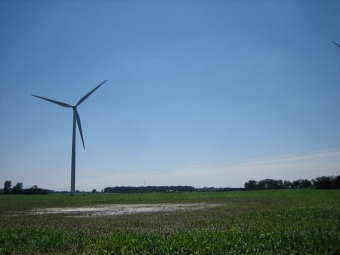The American Wind Energy Association (AWEA) has provided some projections for 2009.
“The world’s largest operating wind power project” will be a hotly
contested designation this year: At least one new project may soon
surpass FPL Energy’s 736-megawatt (MW) Horse Hollow wind farm, which
has been the world’s largest for three years running. One project under
expansion, by E.ON Climate & Renewables (EC&R) North America,
and currently scheduled to go online in mid-2009, would have a total
capacity of 781.5 megawatts (MW) when it is completed.
Hopes
run high for greater federal policy stability. President-elect Obama
has outlined a range of policies that would encourage investments in
wind and renewables, and these policies are expected to be on the table
for serious discussion and possible early action in 2009. The policies
would signal a welcome shift for renewable energy technologies, whose
deployment has been hampered by the absence of long-term policy
stability.
New policies include:
• adjusting the federal
production tax credit (PTC) to make it more effective in the midst of
the current economic downturn and extending it for a longer term (it
expires at the end of 2009);
• establishing a national
renewable electricity standard (RES) with a target of generating at
least 25 percent of the nation’s electricity from renewables by 2025,
and a near-term target of 10 percent by 2012;
• legislation and initiatives to develop a high-voltage interstate transmission “highway” for renewable energy; and
• strong national climate change legislation.
States
will focus on RES, transmission for renewables. Expect one or more
states to implement (Indiana) or strengthen (Wisconsin and New York)
their Renewable Electricity Standards (RES), bringing the number of
states with an RES from 28 to perhaps 30. Look also for some states,
including some without an RES (Oklahoma, Kansas, Nebraska) to develop a
process to facilitate investment in transmission for electricity
generated using renewables. Texas, Colorado, Minnesota, and California
have already shown the way with pro-active transmission policies for
renewable energy.
“Baseload/peaking” is “out” and “smart mix”
is “in.” The electric industry faces dramatic transformations as it
wrestles with the challenges of the 21st century. The old paradigm that
assumed “baseload” power plants were necessary is being replaced by a
new paradigm where both demand and supply are managed in tandem, and
electricity is supplied by a smart, clean mix including a high level of
renewable and flexible technologies. Under its 20 percent wind by 2030
scenario (www.20percentwind.org), the U.S. Department of Energy found
that 20 percent wind would likely reduce the need for new coal and
leave the level of nuclear power unchanged.
The fast-growing wind power market is also opening up opportunities
for community wind, which are projects owned by farmers, ranchers, or
other local investors or public entities. Look for more community wind
proposals in 2009, and more AWEA education and outreach on the topic
over the course of the year.
AWEA business membership will
surge past 2,000 by mid-year. More companies see opportunities in the
wind energy industry, and the expanding AWEA business membership roll
is a measure of that interest. AWEA business membership increased to
more than 600 in 2005, and has soared over the 1,800 mark in 2008.
Industry
will finalize guidelines for wind turbine O&M. When an industry
becomes mainstream, it needs to put in place a variety of standards and
guidelines, and wind power is no exception. AWEA and the wind power
industry are working with the Occupational Safety and Health
Administration (OSHA) to develop safety guidelines for wind turbine
technicians and O&M workers at utility-scale wind projects. AWEA
will be presenting educational Webinars to OSHA personnel in early
2009.
AWEA expects to finalize standards for small wind
turbines: Standards for small wind turbines will help ensure
qualification for the new small wind turbine federal investment credit
that is now available for homeowners and small businesses investing in
a small wind system. Manufacturing standards have long been in place
for utility-scale wind turbines and continue to evolve with the
technology.
Homeowners, farmers, and small-business owners now
benefit from a federal incentive enacted in late 2008 for the purchase
of small wind systems. However, this credit is capped. Owners of small
wind systems with 100 kilowatts (kW) of capacity and less can receive a
credit for 30 percent of the total installed cost of the system, not to
exceed $4,000. For turbines used for homes, the credit is additionally
limited to the lesser of $4,000 or $1,000 per kW of capacity. Look for
an effort to remove this limitation, so that consumers can benefit from
a credit of a full 30 percent of the total cost of a small wind turbine
purchased for an individual home or business.









